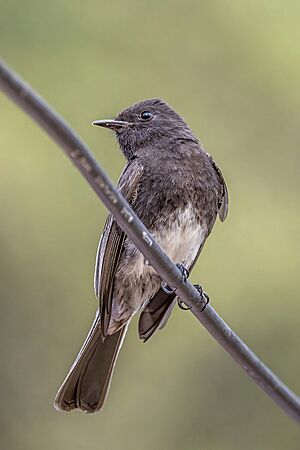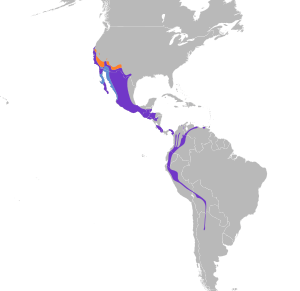Black phoebe facts for kids
Quick facts for kids Black phoebe |
|
|---|---|
 |
|
| Conservation status | |
| Scientific classification | |
| Genus: |
Sayornis
|
| Species: |
nigricans
|
 |
|
The black phoebe (Sayornis nigricans) is a type of bird called a passerine. This means it's a perching bird, like many songbirds you might see. It belongs to the tyrant-flycatcher family. These birds are known for catching insects while flying.
Black phoebes live in many places. You can find them from southwest Oregon and California all the way south through Central and South America. Most black phoebes stay in the same area all year. They don't travel as much as other birds in their family. However, some from colder northern areas might fly south for winter.
This bird is mostly black, but it has a white belly and white feathers under its tail. Male and female black phoebes look the same. Young black phoebes have brown tips on their feathers and brown bars on their wings. Their song sounds like a repeated tee-hee, tee ho. Black phoebes live in different places, but they are always close to water. They mostly eat insects. They wait on a branch, then fly out quickly to catch bugs in the air. They build a cup-shaped nest under cliffs or bridges, using mud to stick it in place.
Contents
What Does a Black Phoebe Look Like?
The black phoebe is a medium-sized flycatcher. It is about 16 cm (6.3 in) long. It weighs between 15 to 22 g (0.5 to 0.8 oz), which is about as much as a few quarters.
Its body is mostly black. But its belly and the feathers under its tail are white. This white part forms a shape like an upside-down "V" on its lower chest. Both male and female black phoebes have the same colors all year round. Young black phoebes look a bit different. They have browner feathers and brown bars on their wings. As they grow, their feathers become darker and blacker. The bird has brown eyes, black legs, black feet, and a black beak.
You can often spot a black phoebe by how it wags its tail. It lowers its tail and fans out the feathers. This is a special movement it does. Black phoebes mostly move by flying. Their flight is straight and steady, with even wing beats. Their song has two parts that go back and forth, sounding like tee-hee, tee-ho or sisee, sitsew. Both male and female phoebes sing, but males sing more often.
About the Black Phoebe's Family
Black phoebes belong to a group of birds called Sayornis. This group is part of the tyrant flycatcher family. The flycatcher family is huge! It has more than 400 different kinds of birds.
The name Sayornis was given by George Robert Gray. He worked at the British Museum. He named the group after Thomas Say, an American naturalist. A naturalist is someone who studies nature. The species name, nigricans, comes from Latin. It means "blackish." William Swainson gave the black phoebe this name in 1827.
There are six types of black phoebes, called subspecies. Sometimes, two of these subspecies are even considered a separate species, known as the white-winged phoebe. These different types live in slightly different areas and might have small differences in their looks.
Where Black Phoebes Live
Black phoebes live and breed in the western and southwestern parts of the United States. They also live in Mexico, Central America, and some parts of South America.
In Oregon, you can find them in river valleys along the Pacific coast. In California, they live on the western side of the Coast Ranges. They also breed all along the Colorado River valley. Sometimes, they are seen further north in southern Nevada and southwestern Utah. You can also find them in Arizona and central New Mexico. Their breeding area in the United States goes as far southeast as the Lower Rio Grande Valley.
In Central America, they live in Baja California and mainland Mexico, down to Panama. In South America, they are found in the coastal mountains of Venezuela, Colombia, Ecuador, and Peru. They also live in western Bolivia and northwestern Argentina.
Most black phoebes stay in their home area all year. They don't migrate (travel long distances) as much as other phoebes. But some from northern areas might move south for winter.
You will always find black phoebes near water. They like coastal cliffs, river banks, lake shores, and even park fountains. They also need mud to build their nests. Because they need mud for their nests, they can only live in certain places.
Images for kids
See also
 In Spanish: Mosquero negro para niños
In Spanish: Mosquero negro para niños




